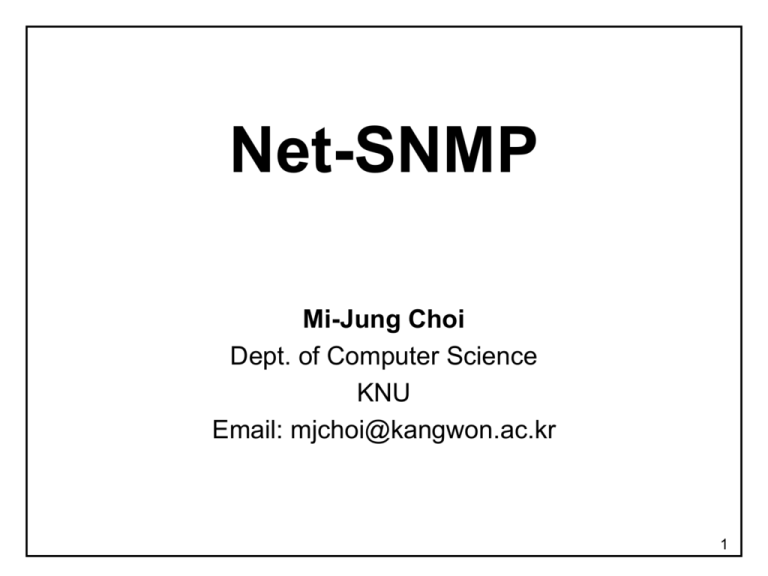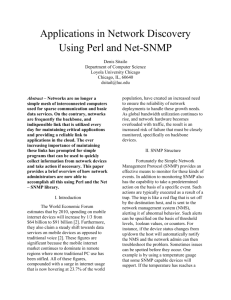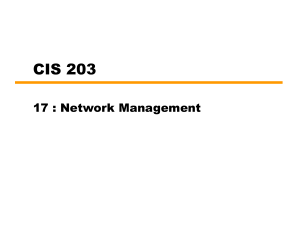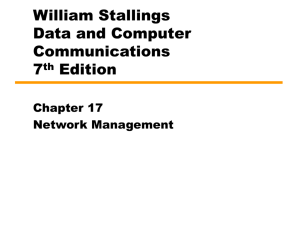Net-SNMP Package
advertisement

Net-SNMP
Mi-Jung Choi
Dept. of Computer Science
KNU
Email: mjchoi@kangwon.ac.kr
1
Contents
• Net-SNMP Package
• History of Net-SNMP
• Applications of Net-SNMP
• Trap Daemon
• Architecture of Net-SNMP Agent
• How to extend SNMP agents with Net-SNMP
• Net-SNMP URL: www.net-snmp.org
2
Net-SNMP Package (1/2)
• Net-SNMP is a suite of applications used to
implement SNMPv1, SNMPv2c and SNMPv3 using
both IPv4 and IPv6 and includes
• Command-line applications to:
– retrieve information from an SNMP-capable device, either
using single requests (snmpget, snmpgetnext), or multiple
requests (snmpwalk, snmptable, snmpdelta).
– manipulate configuration information on an SNMP-capable
device (snmpset).
– retrieve a fixed collection of information from an SNMPcapable device (snmpdf, snmpnetstat, snmpstatus).
– convert between numerical and textual forms of MIB OIDs,
and display MIB content and structure (snmptranslate).
3
Net-SNMP Package (2/2)
• A graphical MIB browser (tkmib), using
Tk/perl.
• A daemon application for receiving SNMP
notifications (snmptrapd).
• An extensible agent for responding to SNMP
queries for management information (snmpd).
• A library for developing new SNMP
applications, with both C and perl APIs.
4
History of Net-SNMP
• Originally based on the Carnegie Mellon
University implementation (1992)
• University of California at Davis SNMP
extends CMU-SNMP, calls UCD-SNMP (1995)
• UCD-SNMP moves to Net-SNMP in April,
2002 (Web sites also moves from www.ucdsnmp.net to www.net-snmp.net)
• Now, Net-SNMP 5.7.3 released
• More detailed history can be found at
http://www.net-snmp.org/about/history.html
5
Applications (1)
•
Common Options
-c community
-v 1 | 2c | 3
-r retries
-t timeout
-p port
• snmpget [COMMON OPTIONS] [-Cf] OID [OID]...
– SNMP application that uses the SNMP GET request to query
for information on a network entity
– e.g., snmpget -c public localhost system.sysDescr.0
– Result) system.sysDescr.0 = Linux enterflex2.postech.ac.kr …
6
Applications (2)
• snmpset [COMMON OPTIONS] OID TYPE VALUE
– SNMP application that uses the SNMP SET request to set
information on a network entity
– Type: i (INTEGER), u (UNSIGNED), s (STRING)…
– e.g., snmpset -c private -v 1 localhost system.sysContact.0 s
mjchoi@postech.ac.kr
• snmpwalk [APPLICATION OPTIONS] [COMMON
OPTIONS] [OID]
– SNMP application that uses SNMP GETNEXT requests to
query a network entity
– Retrieves lots of data, a part of MIB tree (subtree) at once
– e.g., snmpwalk -c public localhost system
– Result)
system.sysDescr.0 = …
system.sysObjectID.0 = …
system.sysUpTime.0 = …
7
Applications (3)
• snmpstatus [COMMON OPTIONS]
– SNMP application that retrieves several important statistics
from a network entity.
– The IP address of the entity. sysDescr.0 / sysUpTime.0 /…
– e.g., snmpstatus -c public -v 1 localhost
– Result) [127.0.0.1] [Linux enterflex2 .postech . ac .kr 2.4.7-10
#1 Thu Sep 6 17 :27:27 EDT 2001 i386 ]…
• snmptranslate [OPTIONS] OID [OID]...
– Application that translates SNMP object identifier values from
their symbolic (textual) forms into their numerical forms
– e.g., snmptranslate system.sysUpTime.0
– Result) .1.3.6.1.2.1.1.3.0
8
Applications (4)
• snmptrap [COMMON OPTIONS] [-Ci] enterprise-oid
agent generic-trap specific-trap uptime [OID TYPE
VALUE]
– SNMP application that uses the SNMP TRAP operation to send
information to a network manager
– Definition)
TRAP-TEST-MIB DEFINITIONS ::= BEGIN
IMPORTS ucdExperimental FROM UCD-SNMP-MIB;
demotraps OBJECT IDENTIFIER ::= { ucdExperimental 990 }
demo-trap TRAP-TYPE
STATUS current
ENTERPRISE demotraps
VARIABLES { sysLocation }
DESCRIPTION "This is just a demo"
::= 17
END
– e.g., snmptrap –v 1 -c public host TRAP-TEST-MIB::demotraps
localhost 6 17 '' SNMPv2-MIB::sysLocation.0 s "Just here"
9
Applications (5)
• Other SNMP applications:
– snmpgetnext: retrieving unknown indexed data.
– snmpbulkwalk: uses SNMP GETBULK requests to
query a network entity
– snmptable: displaying table
– snmpnetstat: symbolically displays the values of
various network-related information retrieved from
a remote system using the SNMP protocol
10
Trap Daemon
• snmptrapd [OPTIONS][LISTENING
ADDRESSES]
– SNMP application that receives and logs SNMP
TRAP
– the default is to listen on UDP port 162
– snmptrapd is displayed as follows
– Result) 1999-11-12 23:26:07 localhost [127.0.0.1]
TRAP-TEST-MIB::demotraps: Enterprise Specific
Trap (demo-trap) Uptime: 1 day, 5:34:06 SNMPv2MIB::sysLocation.0 = "Just here"
11
Architecture of SNMP Agent
Managed System
SNMP Agent
Trap
Monitor
S
N
M
P
M
A
N
A
G
E
R
Message
Generator
Operation
Processor
Mgmt.
Backend
Interface
Embedded
System
Application
Message
Parser
BER Decoder
& Encoder
Response/ Trap
Connection
Listener
Request
12
How to Extend (1)
1. Define a private MIB: Example of Cluster MIB
13
How to Extend (2)
2. Download net-snmp-5.7.3.tar.gz
3. Decompress the file in your home directory
command: gtar xvfz net-snmp-5.7.3.tar.gz
4. Compile default SNMP agent
–
–
–
–
–
cd net-snmp-5.7.3
./configure --prefix=“/usr/local/net-snmp”
make
umask 022
make install
14
How to Extend (3)
6. Install SNMP perl module for using mib2c
• cd net-snmp-5.7.3
• cd perl
• perl Makefile.PL -NET-SNMP-CONFIG=“sh ../netsnmp-config” -NET-SNMP-IN-SOURCE=true
• make
• make test
• make install
15
How to Extend (4)
7. Compile the private MIB file using mib2c
•
•
•
•
•
•
•
•
•
•
•
•
•
cd net-snmp-5.7.3
cd local
mkdir cluster
copy the private mib in the current directory
ex) cp ~mjchoi/cluster.my ./cluster.my
export MIBS=ALL
MIBS=./cluster.my
mib2c -c mib2c.scalar.conf generalInfo
mib2c -c mib2c.scalar.conf currentStatus
mib2c -c mib2c.array-user.conf loadBalancer
mv generalInfo.* cluster
mv currentStatus.* cluster
mv loadBalancer.* cluster
cp –r cluster ../agent/mibgroup/.
16
How to Extend (5)
8. Code the extension agent
• Header file: add necessary definitions
• C file
(1) Module definition: the code defining the contents of the MIB
e.g., static oid
clusterName_oid[] = { 1, 3, 6, 1, 3, 1, 1, 1, 0 };
(2) Module initialization: initialization before they can start
providing the necessary information
e.g.,
netsnmp_register_instance(netsnmp_create_handler_registration
("clusterName", do_clusterName, clusterName_oid,
OID_LENGTH(clusterName_oid),
HANDLER_CAN_RWRITE));
17
How to Extend (6)
8. Code the extension agent
(3) Variable handling: actually handles a request for a particular
variable instance
e.g., char clusterName[NAME_LEN];
int *var_len;
(4) Non-table-based modules: the request handling routine is to
retrieve any necessary scalar data
e.g.,
switch (reqinfo->mode) {
case MODE_GET:
snmp_set_var_typed_value(requests->requestvb, ASN_OCTET_STR,
(u_char *) clusterName, var_len);
break;
…
}
18
How to Extend (7)
8. Code the extension agent
(5) Simple tables: process a simple table with limited table index
e.g., int serviceTable_handler(netsnmp_mib_handler *handler,
netsnmp_handler_registration *reginfo,
netsnmp_agent_request_info *reqinfo,
netsnmp_request_info *requests) {
…
switch (reqinfo->mode) {
case MODE_GET:
switch (table_info->colnum) {
case COLUMN_SRINDEX:
snmp_set_var_typed_value(var, ASN_INTEGER, …);
break;
…}
…
}
…
}
19
How to Extend (8)
8. Code the extension agent
(6) General tables: process a general table, which the maximum
index is not determinable
e.g.,
Init_{Name}_Entry(); // Perform any necessary initialization
while (( index = Get_Next_{Name}_Entry() ) != EndMarker ) {
construct OID from vp->name and index
compare new OID and request
if valid {
save current data
if finished // exact match, or ordered table
break; // so don't look at any more entries
}
…
}
…
20
How to Extend (9)
8. Code the extension agent
(7) Set-able object: the handling of SNMPSET
e.g.,
switch (reqinfo->mode) {
…
case MODE_SET_ACTION:
// XXX: perform the value change here
if ( /* XXX: error? */ ) {
netsnmp_set_request_error(reqinfo, requests, “error_msg.”);
}
break;
case MODE_SET_COMMIT:
// XXX: delete temporary storage
if ( /* XXX: error? */ ) {
netsnmp_set_request_error(reqinfo, requests,
SNMP_ERR_COMMITFAILED);
}
break;
}
…
21
How to Extend (10)
9. Compile the MIB extension and generate SNMP
daemon
•
•
•
•
./configure --with-mib-modules=“cluster/generalInfo,
cluster/currentStatus, cluster/loadBalancer”
cd agent
make
./snmpd –c config_file (ex) ./snmpd –c /etc/snmp/snmpd.conf
– snmpd [OPTIONS] [LISTENING ADDRESSES]
– SNMP agent which binds to a port and awaits requests from SNMP
management software.
– collects the requested information and/or performs the requested
operations and returns the information to the sender.
– By default, snmpd listens for SNMP requests on UDP port 161.
22
How to Extend (11)
10.Modify snmpd.conf for SNMP community
# First, map the community name
#
sec.name source community
com2sec clusterUser default
postech
# Second, map the security name into a group name:
#
groupName
securityModel securityName
group clusterGroup
v1
clusterUser
# Third, create a view for us to let the group have rights to:
#
name
incl/excl
subtree
mask(optional)
view mibview included .iso.org.dod.internet
# Finally, grant the group read-only access to the systemview view.
#
group context sec.model sec.level prefix read write notif
access clusterGroup "" any noauth exact mibview mibview none
23
Good-Luck
&
Have Fun!
24






